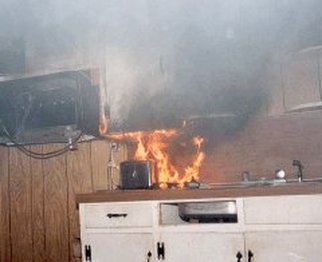COOKING FIRES
Cooking fires are the #1 cause of home fires and home fire injuries. Most cooking equipment fires start with the ignition of common household items (e.g., food or grease, cabinets, wall coverings, paper or plastic bags, curtains, etc.).
Facts & Figures*
*From NFPA's Home Cooking Fire Patterns and Trends, January 2005
Safety tips
Facts & Figures*
- In 2001, there were 117,100 reported home structure fires associated with cooking
equipment, resulting in 370 deaths, 4,290 injuries and $453 million in direct property damage. - Unattended cooking is the leading cause of home cooking fires.
- Three in every 10 reported home fires start in the kitchen more than any other place in the home.
- Two out of three reported home cooking fires start with the range or stove.
- Electric ranges or stoves have a higher risk of fires, injuries and property damage, relative to usage, than gas ranges or stoves, but gas ranges or stoves have a higher risk of fire deaths.
*From NFPA's Home Cooking Fire Patterns and Trends, January 2005
Safety tips
- Always use cooking equipment tested and approved by a recognized testing facility.
- Never leave cooking food on the stovetop unattended, and keep a close eye on food cooking inside the oven.
- Keep cooking areas clean and clear of combustibles (e.g. potholders, towels, rags, drapes and food packaging).
- Keep children away from cooking areas by enforcing a "kid-free zone" of three feet
(1 meter) around the stove. Keep pets from underfoot so you do not trip while cooking. Also, keep pets off cooking surfaces and nearby countertops to prevent them from knocking things onto burner.Wear short, close fitting or tightly rolled sleeves when cooking. Loose clothing can dangle onto stove burners and catch fire. - Never use a wet oven mitt, as it presents a scald danger if the moisture in the mitt is heated.
- Always keep a potholder, oven mitt and lid handy. If a small fire starts in a pan on the stove, put on an oven mitt and smother the flames by carefully sliding the lid over the pan. Turn off the burner. Don't remove the lid until it is completely cool. Never pour water on a grease fire and never discharge a fire extinguisher onto a pan fire, as it can spray or shoot burning grease around the kitchen, actually spreading the fire.
- If there is an oven fire, turn off the heat and keep the door closed to prevent flames from burning you and your clothing.
- If there is a microwave fire, keep the door closed and unplug the microwave. Call the fire department and make sure to have the oven serviced before you use it again. Food cooked in a microwave can be dangerously hot. Remove the lids or other coverings from microwaved food carefully to prevent steam burns.

